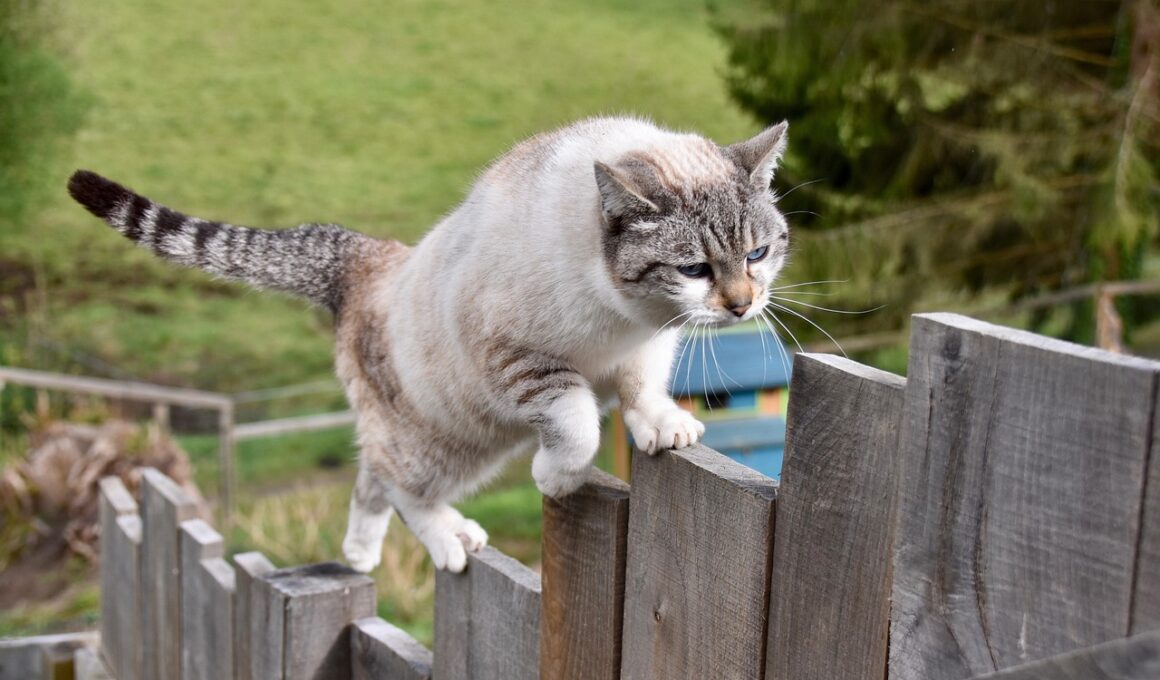How to Set Up an Indoor Cat Agility Course
Creating an indoor agility course for your cat can be a fun and engaging activity that boosts both their physical and mental well-being. Start by assessing the available space in your home, ensuring it’s safe, spacious, and free from hazards. Select a room with ample light and minimal distractions to keep your cat focused. Gather a variety of materials such as cardboard boxes, pillows, and soft furniture that can be used as obstacles. Creating a safe space allows your cat to explore and practice different activities without the risk of injury. It’s crucial to use household items that are sturdy and stable. Introduce toys to encourage your cat to engage with the course. Toys can serve as motivational tools that prompt them to navigate through the course elements. Most importantly, ensure to supervise your kitty during playtime to prevent accidents. The goal is to create an enjoyable experience for both you and your furry friend. Engaging in such activities can strengthen the bond between you and ensure a happier, healthier cat.
To continue creating your indoor cat agility course, consider integrating a variety of obstacles that can challenge your feline friend. Options include tunnels made from cardboard or fabric, low jumps using broomsticks balanced on sturdy objects, and soft platforms for climbing. Use fabric or lightweight materials to create a tunnel effect, encouraging your cat to crawl and explore. Ensure the obstacles are appropriately sized for your cat’s breed and physical capabilities, avoiding anything that is too tall or risky. It’s also essential to have a surface that provides traction, so your cat can safely navigate the course without slipping. Always position obstacles in a pattern that makes logical sense to your cat, such as a straight line or an easy circuit. To make the course interactive, use treats or toys that lure and motivate your cat to navigate through. Experiment with different configurations and designs to keep the experience fresh and exciting. Gradually increase the difficulty level as your cat becomes more accustomed to each obstacle. Keep things playful to encourage further exploration and engagement.
When setting up an indoor cat agility course, don’t forget the importance of positive reinforcement. This strategy will motivate your cat and boost their confidence as they navigate through the obstacles. Whenever your cat successfully completes a jump or crawls through a tunnel, reward them immediately with praise, pets, or treats. This will help them associate the agility course with fun and success. Over time, your cat will become more excited to participate as they learn that following your cues leads to rewards. Consistency is key here; ensure that the rewards are given each time they perform correctly to solidify this behavior. Furthermore, adjust your interaction based on your cat’s reactions and preferences. Some cats may prefer treats, while others may enjoy playful engagements. Be patient as your cat learns the agility course; some may take longer to adapt than others. Maintain a relaxed environment, keeping the sessions short to prevent frustration. Playtime should be fun and not forced, which encourages a positive association with agility training!
Safety Considerations for Indoor Agility
As you create the agility course, prioritizing your cat’s safety is essential. Inspect the space regularly for any potential hazards—like sharp objects or fragile items—that might risk injury. Make sure all obstacles are securely placed and stable to prevent tipping over when your cat engages with them. Additionally, avoid using materials that could break easily or pose choking hazards. Watch out for small decorations or items that can be easily swallowed. Having a clear space without clutter is also advisable, allowing your cat to move freely without risk. Always supervise your cat during practice sessions to ensure their safety, especially when they appear anxious while trying out new obstacles. Cats can be unpredictable, so having a watchful eye can prevent accidents. If your cat ever shows signs of stress or discomfort, allow them time to relax and become accustomed to the new training environment. Remember, the aim is to create a positive experience rather than forcing participation, allowing them to enjoy the fun in agility training.
Once your indoor agility course is set up, it’s beneficial to develop a regular training schedule. Engaging your cat in agility activities multiple times a week can not only keep them physically fit but also mentally stimulated. Consistent sessions help your pet become familiar with the course layout and improve their confidence in navigating the obstacles. Try to schedule these play sessions at times when your cat is active and engaged, such as during their natural playtimes. Start with short sessions of around 10 minutes, gradually increasing the duration as your cat becomes more comfortable and enjoys the training. Mixing up obstacles and introducing variations keeps the atmosphere lively and exciting, preventing boredom. Don’t forget to include periods of play without the agility course, allowing your feline friend to interact freely. This balance helps maintain their overall enthusiasm about training. Keep a journal or log of your sessions to track progress and improvements, noting what your cat enjoys the most. Celebrating small victories during practice can be a wonderful way to bond with your furry friend.
Incorporating Fun Challenges
Adding fun challenges to your indoor agility course can elevate the level of engagement for your cat. These can include timed runs, obstacle courses with varying paths, or tricks that require your cat to jump or crawl. You might also consider using different textures, such as placing blankets, towels, or mats to alter the experience. By diversifying challenges, you provide a unique experience each time, enhancing their physical agility and mental sharpness. To make it even more stimulating, create themes around specific days. For example, turn an agility day into a treasure hunt by hiding treats around the course. This will spark your cat’s natural hunting instincts while encouraging them to move through the obstacles. Involving friends or family in the training process can further motivate both you and your cat, adding a social aspect to the play. Remember to keep challenges manageable; too difficult and your cat may become frustrated. Ensure that each session focuses on fun and exploration, celebrating their efforts regardless of perfection. This will help establish a secure bonding environment.
Finally, always review and refine your indoor agility course based on your cat’s progress and interactions. Pay attention to which obstacles your cat enjoys the most and fine-tune those to maintain their interest. Make adjustments according to their evolving skill levels or preferences. If they struggle with specific obstacles, consider altering them to be more inviting to your cat. Engage in regular cleanups to ensure all items are safe and functional. Additionally, keeping the space decluttered and organized will create a more enjoyable environment for training. Introduce new elements slowly, allowing your cat to adjust. You might decide to rotate certain pieces in and out to keep things fresh and prevent monotony. Schedule regular breaks within each training session, allowing your cat time to rehydrate and relax. Be patient through this learning process, as every cat has a unique pace for mastering agility training. Your dedication to refining and adapting this role will strengthen your bond, resulting in a fun and healthy activity for your beloved pet.


